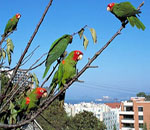
 Import recent article about the trends in parrots as pets, from an award- winning journalist. Import recent article about the trends in parrots as pets, from an award- winning journalist.
Plenty to Squawk About
Exotic Birds Emerged as the Fastest-Growing Pet
Choice in the ’90s. Now Abandoned Parrots Fly Wild
Throughout Southern California. Why Polly Needs
Better Protection.
By Mira Tweti
Mira Tweti is a Los Angeles-based freelance writer.
July 20, 2003
On any given day, sounds of the jungle can be heard from a number of places in Los
Angeles a large ficus near the Westside Pavilion, or among the trees in Mar Vista,
Venice and West Hollywood’s Plummer Park. Many residents are aware of their
boisterous avian neighbors: wild flocks of little yellow-chevroned parakeets, large scarlet
macaws from South America, cockatoos from Indonesia and Australia, lilac-crowned
parrots from Mexico, red-masked parakeets and others all members of the parrot
family. Flying low in the sky, their mega-decibel squawks are unmistakable.
California is now home to at least 10 breeding species of parrots, according to
ornithologists Bill Pranty of the Archbold Biological Station in Florida and Kimball
Garrett of the Los Angeles Natural History Museum. Based on extensive research, they
estimate that nearly 7,000 parrots are living wild from San Francisco to San Diego, and
20,000 are flying around cities throughout the country. Florida, in fact, may now boast
the most diverse group of exotic parrots in the world.
It’s quite a sight to witness these colorful flocks in flight or roosting in a tree, but there’s a
troubling fact behind this phenomenon all of those wild birds were once pets. Exotic
birds were America’s fastest-growing pet choice in the 1990s. Their numbers have
grown according to pet industry research from an estimated 11.6 million at the
decade’s outset to 40 million today, compared with 77.6 million cats and 65 million dogs.
The exponential growth might have something to do with the nation’s two largest pet
store chains, Petco Animal Supplies Inc. and PetsMart Inc., which started selling birds
during the ’90s.
But once the birds are brought home, owners quickly discover that parrots though smart
and affectionate make terrible pets. Consequently, they are being set loose at alarming
rates, despite the illegality of releasing nonnative birds in the U.S. Parrots now appear to
be the fastest-growing group of unwanted pets, as evidenced by the wild flocks and the
number of avian rescuers that are cropping up.
Some action is clearly needed. Wild parrots are among the most endangered group of
birds on the planet. Now, parrots bred for the pet industry in the U.S. unable to be
repatriated in the wild because their survival skills aren’t developed could be euthanized
in captivity to reduce the number of unwanted birds.
Polly doesn’t need a cracker. Polly needs protection.
Read full article...
|

